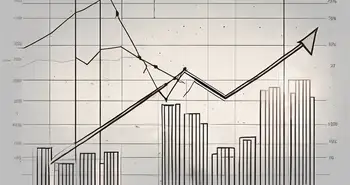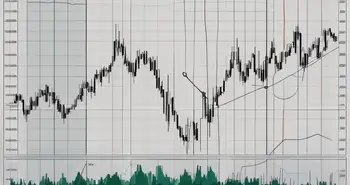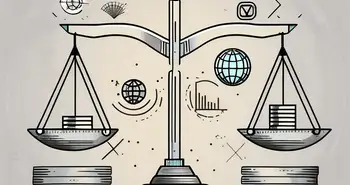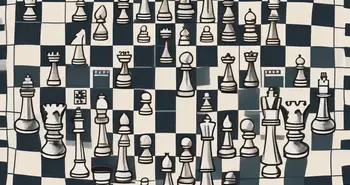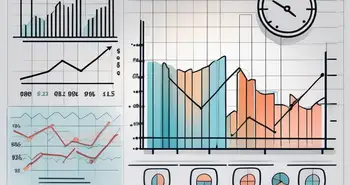Understanding Economic Depreciation: A Comprehensive Guide

As an expert in the field of economics, I am often asked about the concept of economic depreciation. This comprehensive guide aims to demystify economic depreciation and provide you with a thorough understanding of its definition, mechanism, measurement, and implications for businesses. By the end of this article, you will have a solid foundation of knowledge that will enable you to navigate the complex world of economic depreciation with confidence.
Defining Economic Depreciation
Let's start by defining economic depreciation. Economic depreciation refers to the decrease in the value of an asset over time due to various factors such as wear and tear, obsolescence, and changes in market conditions. Unlike accounting depreciation, which is based on the historical cost of an asset, economic depreciation takes into account the current market value and considers the impact of external factors on the asset's worth.
The Basics of Economic Depreciation
To understand economic depreciation, it is essential to grasp a few key concepts. Firstly, assets depreciate over time due to natural wear and tear or technological advancements rendering them less valuable. For example, a computer that was top-of-the-line a few years ago may now be considered outdated and less valuable due to advancements in technology. This decrease in value is a result of economic depreciation.
Secondly, market forces play a significant role in determining the rate of economic depreciation. Changes in market conditions, such as shifts in supply and demand, can impact the value of an asset. For instance, if there is a decrease in demand for a particular product, the value of the assets used to produce that product may also decline. This is because the asset's worth is closely tied to its ability to generate revenue in the market.
Finally, economic depreciation affects not only tangible assets like machinery or buildings but also intangible assets like patents or trademarks. Intangible assets can lose value over time due to changes in market perception, legal challenges, or the emergence of new technologies that make the existing patents or trademarks less valuable.
Key Factors Influencing Economic Depreciation
There are several factors that influence the rate of economic depreciation. Technological advancements can render an asset obsolete, leading to a quicker decline in value. For example, the introduction of a new and more efficient manufacturing process may make older machinery less valuable.
Market demand, industry trends, and changes in consumer preferences also play a crucial role in economic depreciation. If there is a shift in consumer preferences towards a different product, the value of assets used to produce the less favored product may decrease. Similarly, changes in industry trends, such as the adoption of new production methods, can impact the value of assets that are no longer in line with the latest practices.
Additionally, the quality of maintenance, regular upgrades, and the overall condition of an asset can affect its economic depreciation rate. Well-maintained assets that receive regular upgrades may depreciate at a slower rate compared to assets that are poorly maintained and outdated. Regular maintenance and upgrades can help extend the useful life of an asset and slow down its decline in value.
It is important for businesses and individuals to understand economic depreciation and its influencing factors as it can have significant implications for financial planning, asset management, and investment decisions. By considering the various factors that contribute to economic depreciation, stakeholders can make informed choices to mitigate the impact of depreciation and maximize the value of their assets.
The Mechanism of Economic Depreciation
Now that we have a basic understanding of economic depreciation, let's delve into how it works. Economic depreciation occurs gradually, with the value of an asset decreasing over its useful life. This decline in value is typically nonlinear, meaning that the rate of depreciation may vary over time. Market forces, such as changes in supply and demand dynamics, can accelerate or decelerate the rate of depreciation.
How Economic Depreciation Works
Economic depreciation can be best explained through an example. Consider a manufacturing company that invests in new machinery. Initially, the machinery has a high market value and contributes significantly to the company's production capabilities. However, as time passes and newer technologies emerge, the value of the machinery decreases. It may become less efficient, more expensive to maintain, or no longer meet the industry's evolving standards. This gradual decline in value is a result of economic depreciation.
Let's take a closer look at how economic depreciation works in practice. As the manufacturing company continues to use the machinery, wear and tear gradually take their toll. The constant use and exposure to various operating conditions can cause parts to deteriorate, reducing the overall performance of the machinery. This decline in performance can lead to decreased productivity, increased downtime, and higher maintenance costs.
Furthermore, technological advancements in the industry can render the machinery outdated. Newer models with improved features and capabilities may enter the market, making the company's existing machinery less desirable. As a result, the demand for the older machinery decreases, leading to a decline in its market value. The company may find it challenging to sell the machinery at a price comparable to its initial investment.
In addition to wear and tear and technological advancements, changes in consumer preferences can also contribute to economic depreciation. As consumer tastes and preferences evolve, the demand for certain products may decrease. This can impact the value of assets used in the production of those products. For example, if there is a shift in consumer preferences towards eco-friendly packaging, the value of machinery used for traditional packaging methods may decline.
The Role of Market Forces in Economic Depreciation
Market forces play a crucial role in economic depreciation. Supply and demand dynamics, technological advancements, and changes in consumer preferences can all influence the rate at which an asset depreciates. For example, a sudden surge in demand for electric vehicles can lead to a rapid decline in the value of traditional combustion engine cars. Similarly, advancements in 3D printing technology can render traditional manufacturing equipment less valuable.
Supply and demand dynamics can have a significant impact on economic depreciation. If the supply of a particular asset exceeds the demand, its value is likely to decrease. This can occur when there is a surplus of similar assets in the market, leading to increased competition among sellers. On the other hand, if the demand for an asset exceeds the supply, its value may appreciate instead.
Technological advancements can also accelerate economic depreciation. As new technologies emerge, older assets may become obsolete or less efficient. For example, the introduction of automated machinery can make manual labor-intensive equipment less valuable. Similarly, the development of more energy-efficient appliances can reduce the value of older, less efficient models.
Lastly, changes in consumer preferences can impact economic depreciation. As consumer tastes and preferences shift, the demand for certain products may decline, affecting the value of assets used in their production. For instance, if there is a growing preference for organic food products, the value of machinery used for conventional farming methods may decrease.
In conclusion, economic depreciation is a gradual process in which the value of an asset decreases over time. This decline is influenced by various factors, including wear and tear, technological advancements, and changes in consumer preferences. Market forces, such as supply and demand dynamics, play a significant role in determining the rate at which an asset depreciates. Understanding the mechanism of economic depreciation is essential for businesses and investors to make informed decisions regarding their assets.
Measuring Economic Depreciation
Now that we understand how economic depreciation works, let's explore how we can measure it. Accurately assessing economic depreciation is essential for businesses to make informed decisions regarding the replacement or upgrade of assets.
Tools for Assessing Economic Depreciation
There are various tools and methods available for measuring economic depreciation. Businesses can use techniques such as discounted cash flow analysis, market-based approaches, or regression analysis to estimate the decline in an asset's value over time. These methods rely on historical data, market trends, and industry benchmarks to provide a quantitative assessment of economic depreciation.
Interpreting Economic Depreciation Rates
Interpreting economic depreciation rates requires a deep understanding of the specific industry, market conditions, and the asset in question. A higher depreciation rate may indicate a rapidly changing industry or an asset that is approaching obsolescence. On the other hand, a lower depreciation rate may suggest a stable market or an asset with potential for long-term value retention.
Economic Depreciation and Business Strategy
Understanding the implications of economic depreciation is vital for businesses to formulate effective strategies. Let's explore how economic depreciation can impact a company's decision-making process and its long-term sustainability.
Implications of Economic Depreciation for Businesses
Economic depreciation directly impacts a company's balance sheet, profitability, and competitiveness in the market. Businesses need to account for the declining value of assets when valuing their overall net worth. Failing to consider economic depreciation can lead to overvaluation of assets and misguidance in strategic planning.
Mitigating the Effects of Economic Depreciation
To mitigate the effects of economic depreciation, businesses can employ various strategies. Regular maintenance, upgrades, and embracing new technologies can prolong the useful life of assets and reduce the rate of depreciation. Additionally, diversification of product offerings, staying abreast of market trends, and anticipating changes in consumer preferences can help businesses adapt to evolving market conditions.
Economic Depreciation in Different Sectors
Finally, let's explore how economic depreciation manifests in different sectors of the economy. While the concept of economic depreciation applies to all industries, there are specific considerations to be taken into account depending on the sector.
Economic Depreciation in Manufacturing
In the manufacturing sector, economic depreciation plays a significant role. Machinery, equipment, and manufacturing facilities are subject to technological advancements and changes in production techniques. As new technologies emerge, older equipment may quickly lose value, necessitating timely upgrades to remain competitive.
Economic Depreciation in Service Industries
Service industries also experience economic depreciation, albeit in different ways. In sectors such as software development or consulting, where intangible assets like intellectual property and expertise are critical, economic depreciation occurs due to changes in market demand, evolving customer needs, and the emergence of new competitors. Staying at the forefront of industry trends and constantly upskilling is crucial in service-oriented businesses.
Frequently Asked Questions about Economic Depreciation
1. What is economic depreciation?
Economic depreciation refers to the decline in the value of an asset over time due to factors such as wear and tear, obsolescence, and changes in market conditions.
2. How does economic depreciation differ from accounting depreciation?
While accounting depreciation is based on the historical cost of an asset, economic depreciation considers the current market value and external factors affecting the asset's worth.
3. What factors influence economic depreciation?
Economic depreciation is influenced by factors such as technological advancements, market demand, industry trends, asset maintenance, and overall asset condition.
4. How can businesses measure economic depreciation?
Businesses can measure economic depreciation using tools and methods such as discounted cash flow analysis, market-based approaches, or regression analysis.
5. How does economic depreciation impact business strategy?
Economic depreciation can directly impact a company's financials and competitiveness. It is crucial for businesses to consider economic depreciation when valuing assets and formulating long-term strategies.
Having a comprehensive understanding of economic depreciation is essential for businesses and individuals alike. By recognizing the factors influencing economic depreciation and employing appropriate measurement techniques, businesses can make informed decisions about asset management, strategic planning, and long-term sustainability.
Thank you for joining me on this journey through the world of economic depreciation. I hope this guide has equipped you with the knowledge necessary to navigate the complexities of this topic with confidence. Remember, economic depreciation is not a hindrance, but rather an opportunity to adapt and thrive in a rapidly changing economic landscape.
As you consider the implications of economic depreciation on your investments, Morpher offers a cutting-edge solution to navigate and capitalize on market changes. With its zero-fee structure, infinite liquidity, and the ability to trade across multiple asset classes, Morpher empowers you to adapt to economic shifts with ease. Whether you're looking to invest fractionally, short sell, or leverage your trades, Morpher's blockchain-based platform provides the safety, control, and unique trading experience you need to stay ahead. Ready to transform your trading strategy in the face of economic depreciation? Sign Up and Get Your Free Sign Up Bonus at Morpher.com today and join the future of investing.

Disclaimer: All investments involve risk, and the past performance of a security, industry, sector, market, financial product, trading strategy, or individual’s trading does not guarantee future results or returns. Investors are fully responsible for any investment decisions they make. Such decisions should be based solely on an evaluation of their financial circumstances, investment objectives, risk tolerance, and liquidity needs. This post does not constitute investment advice.

Painless trading for everyone
Hundreds of markets all in one place - Apple, Bitcoin, Gold, Watches, NFTs, Sneakers and so much more.

Painless trading for everyone
Hundreds of markets all in one place - Apple, Bitcoin, Gold, Watches, NFTs, Sneakers and so much more.


